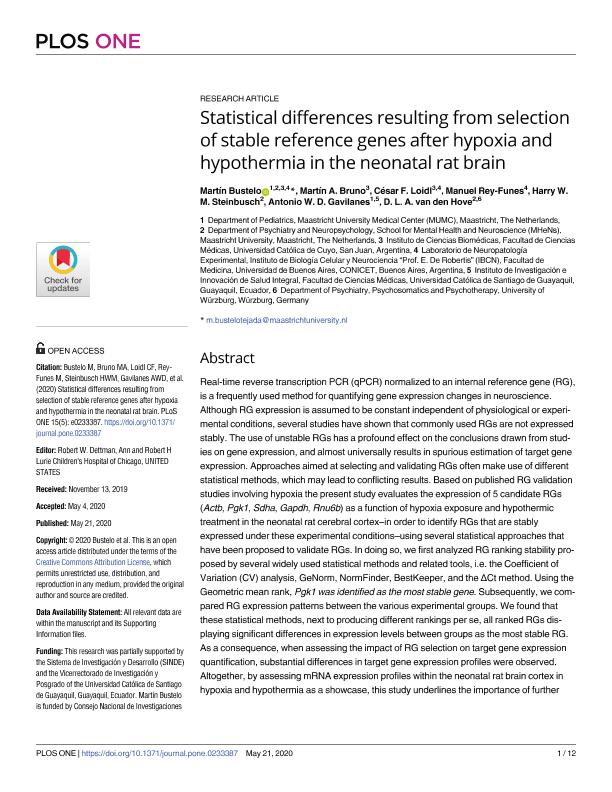Mostrar el registro sencillo del ítem
dc.contributor.author
Bustelo Tejada, Martin

dc.contributor.author
Bruno, Martin

dc.contributor.author
Loidl, Cesar Fabian

dc.contributor.author
Rey Funes, Manuel
dc.contributor.author
Steinbusch, Harry W. M.
dc.contributor.author
Gavilanes, Antonio W. D.
dc.contributor.author
van den Hove, D. L. A.
dc.date.available
2022-03-23T20:06:33Z
dc.date.issued
2020-05
dc.identifier.citation
Bustelo Tejada, Martin; Bruno, Martin; Loidl, Cesar Fabian; Rey Funes, Manuel; Steinbusch, Harry W. M.; et al.; Statistical differences resulting from selection of stable reference genes after hypoxia and hypothermia in the neonatal rat brain; Public Library of Science; Plos One; 15; 5; 5-2020; 1-12
dc.identifier.issn
1932-6203
dc.identifier.uri
http://hdl.handle.net/11336/153857
dc.description.abstract
Real-time reverse transcription PCR (qPCR) normalized to an internal reference gene (RG), is a frequently used method for quantifying gene expression changes in neuroscience. Although RG expression is assumed to be constant independent of physiological or experimental conditions, several studies have shown that commonly used RGs are not expressed stably. The use of unstable RGs has a profound effect on the conclusions drawn from studies on gene expression, and almost universally results in spurious estimation of target gene expression. Approaches aimed at selecting and validating RGs often make use of different statistical methods, which may lead to conflicting results. Based on published RG validation studies involving hypoxia the present study evaluates the expression of 5 candidate RGs (Actb, Pgk1, Sdha, Gapdh, Rnu6b) as a function of hypoxia exposure and hypothermic treatment in the neonatal rat cerebral cortex–in order to identify RGs that are stably expressed under these experimental conditions–using several statistical approaches that have been proposed to validate RGs. In doing so, we first analyzed RG ranking stability proposed by several widely used statistical methods and related tools, i.e. the Coefficient of Variation (CV) analysis, GeNorm, NormFinder, BestKeeper, and the ΔCt method. Using the Geometric mean rank, Pgk1 was identified as the most stable gene. Subsequently, we compared RG expression patterns between the various experimental groups. We found that these statistical methods, next to producing different rankings per se, all ranked RGs displaying significant differences in expression levels between groups as the most stable RG. As a consequence, when assessing the impact of RG selection on target gene expression quantification, substantial differences in target gene expression profiles were observed. Altogether, by assessing mRNA expression profiles within the neonatal rat brain cortex in hypoxia and hypothermia as a showcase, this study underlines the importance of further validating RGs for each individual experimental paradigm, considering the limitations of the statistical methods used for this aim.
dc.format
application/pdf
dc.language.iso
eng
dc.publisher
Public Library of Science

dc.rights
info:eu-repo/semantics/openAccess
dc.rights.uri
https://creativecommons.org/licenses/by/2.5/ar/
dc.subject
Reference genes
dc.subject
Hypoxia
dc.subject
Hypothermia
dc.subject
Newborn brain
dc.subject.classification
Bioquímica y Biología Molecular

dc.subject.classification
Ciencias Biológicas

dc.subject.classification
CIENCIAS NATURALES Y EXACTAS

dc.title
Statistical differences resulting from selection of stable reference genes after hypoxia and hypothermia in the neonatal rat brain
dc.type
info:eu-repo/semantics/article
dc.type
info:ar-repo/semantics/artículo
dc.type
info:eu-repo/semantics/publishedVersion
dc.date.updated
2022-03-14T21:15:39Z
dc.journal.volume
15
dc.journal.number
5
dc.journal.pagination
1-12
dc.journal.pais
Estados Unidos

dc.journal.ciudad
San Francisco
dc.description.fil
Fil: Bustelo Tejada, Martin. Universidad Católica de Cuyo - Sede San Juan. Facultad de Ciencias Médicas. Departamento de Neurociencia; Argentina. Universiteit Maastricht.; Países Bajos. Consejo Nacional de Investigaciones Científicas y Técnicas. Oficina de Coordinación Administrativa Houssay. Instituto de Biología Celular y Neurociencia "Prof. Eduardo de Robertis". Universidad de Buenos Aires. Facultad de Medicina. Instituto de Biología Celular y Neurociencia; Argentina
dc.description.fil
Fil: Bruno, Martin. Universidad Católica de Cuyo - Sede San Juan. Facultad de Ciencias Médicas. Departamento de Neurociencia; Argentina. Consejo Nacional de Investigaciones Científicas y Técnicas. Centro Científico Tecnológico Conicet - San Juan; Argentina
dc.description.fil
Fil: Loidl, Cesar Fabian. Universidad Católica de Cuyo - Sede San Juan. Facultad de Ciencias Médicas. Departamento de Neurociencia; Argentina. Consejo Nacional de Investigaciones Científicas y Técnicas. Oficina de Coordinación Administrativa Houssay. Instituto de Biología Celular y Neurociencia "Prof. Eduardo de Robertis". Universidad de Buenos Aires. Facultad de Medicina. Instituto de Biología Celular y Neurociencia; Argentina
dc.description.fil
Fil: Rey Funes, Manuel. Consejo Nacional de Investigaciones Científicas y Técnicas. Oficina de Coordinación Administrativa Houssay. Instituto de Biología Celular y Neurociencia "Prof. Eduardo de Robertis". Universidad de Buenos Aires. Facultad de Medicina. Instituto de Biología Celular y Neurociencia; Argentina
dc.description.fil
Fil: Steinbusch, Harry W. M.. Universiteit Maastricht.; Países Bajos
dc.description.fil
Fil: Gavilanes, Antonio W. D.. Universiteit Maastricht.; Países Bajos. Universidad Católica de Santiago de Guayaquil; Ecuador
dc.description.fil
Fil: van den Hove, D. L. A.. Universiteit Maastricht.; Países Bajos. Universität Würzburg; Alemania
dc.journal.title
Plos One

dc.relation.alternativeid
info:eu-repo/semantics/altIdentifier/url/https://dx.plos.org/10.1371/journal.pone.0233387
dc.relation.alternativeid
info:eu-repo/semantics/altIdentifier/doi/http://dx.doi.org/10.1371/journal.pone.0233387
Archivos asociados
